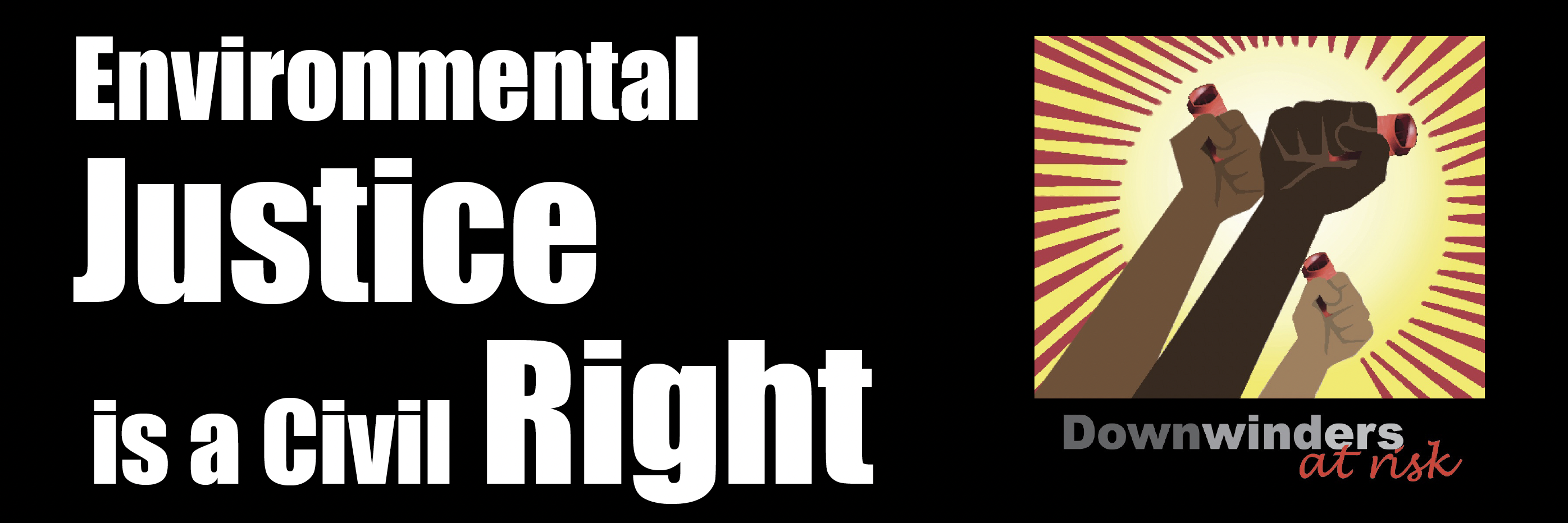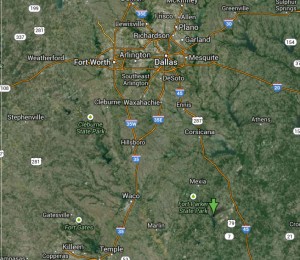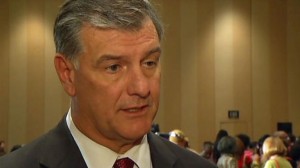Fracking
Beginning at 1pm Today, Walk the Last 1500 Feet With Us
 It's been four years since the first Dallas City Plan Commission meetings on pending gas permits. It's been three years since the Dallas Gas Drilling Task Force was formed. It's been 12 months since Mayor Rawlings' announced he was fast tracking the Trinity East gas permits. It's been 10 months since the Dallas Observer published former City Manager's embarrassing secret deal over park land drilling between herself and Trinity East. It's been seven months since Suhm announced her retirement. It's been four months since the Trinity East permits went down in defeat. It's been three months since the Plan Commission passed its draft of the new Dallas Gas Ordinance, including a provision for a 1500-foot setback. What a long, strange trip.
It's been four years since the first Dallas City Plan Commission meetings on pending gas permits. It's been three years since the Dallas Gas Drilling Task Force was formed. It's been 12 months since Mayor Rawlings' announced he was fast tracking the Trinity East gas permits. It's been 10 months since the Dallas Observer published former City Manager's embarrassing secret deal over park land drilling between herself and Trinity East. It's been seven months since Suhm announced her retirement. It's been four months since the Trinity East permits went down in defeat. It's been three months since the Plan Commission passed its draft of the new Dallas Gas Ordinance, including a provision for a 1500-foot setback. What a long, strange trip.
Today, we're down to the final public hearing and the final council vote on that new ordinance. The only mystery left is whether that 1500-foot setback will remain in place or be whittled back to allow drilling as close as 500 feet to homes. It's the difference between matching the most protective buffer zone in the region, or following the lead of the most permissive cities in the Shale like Fort Worth.
We're poised to win one of the biggest victories against the gas lobby in North Texas since urban drilling began in 2006. We're on the verge of creating a new model for cities, one that better incorporates the newest science and technology. All it takes is one more push, one more vote.
Many of you have been with us every step since 2011. Many others have fallen in along the way. We're asking all of you to walk that final 1500 feet with us today. Come down to City Hall at 1 and participate in the news conference in the Flag Room on the 6th floor just outside the Council Chambers. Speak for the allotted three minutes at the public hearing on the gas ordinance that will follow, witness history, and then come to what we hope will be a victory celebration at Lee Harvey's afterwards.
Don't let the last four years be in vain. Come on down to City Hall and help us finish the job. Thanks.
Better Living Avoiding This Chemistry: An Industrial Toxic Primer
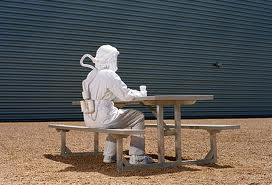 Even though this EcoNews article is about air poisons that result from fossil fuel production, it applies to just about any combustion source, including cement plants, manufacturing plants, vehicles, and so on. It's a pretty good top ten list, although you wonder why Dioxins and Furans got left off, since they're toxic by the gram instead of pound. Also missing is Particulate Matter as a stand alone threat, although it gets a shout out as a by-product. Nevertheless, these are the among the most dangerous pollutants that have caused and are still causing a lot of problems in North Texas and elsewhere:
Even though this EcoNews article is about air poisons that result from fossil fuel production, it applies to just about any combustion source, including cement plants, manufacturing plants, vehicles, and so on. It's a pretty good top ten list, although you wonder why Dioxins and Furans got left off, since they're toxic by the gram instead of pound. Also missing is Particulate Matter as a stand alone threat, although it gets a shout out as a by-product. Nevertheless, these are the among the most dangerous pollutants that have caused and are still causing a lot of problems in North Texas and elsewhere:
1. Benzene
Benzene is a well-established carcinogen with specific links to leukemia as well as breast and urinary tract cancers. Exposure to benzene reduces red and white blood cell production in bone marrow; decreases auto-immune cell function (T-cell and B-cells); and has been linked to sperm-head abnormalities and generalized chromosome aberrations.
Benzene is one of the largest-volume petrochemical solvents used in the fossil fuel industry. It is a major component in all major fossil fuel production: oil, coal and gas. People are exposed to it from inhaling automobile exhaust and gasoline fumes, industrial burning such as oil and coal combustion, and exposure to fracking fluids.
There's a recent Emory University study concluding that risk for leukemia fell with every mile between a person's home and facilities that release benzene.
2. & 3. Sulfur Dioxide (SO2) and Nitrogen Oxides (NOx)
Sulfur dioxide (SO2) and nitrogen oxides (NOx) are two primary examples of particle-forming air pollutants (particulate matter). Particulate matter is known to contribute to serious health problems, including lung cancer and other cardiopulmonary mortality. SO2 and NOx are both highly toxic to human health, and contribute directly to thousands of hospitalizations, heart attacks and deaths annually.
SO2 is particularly dangerous for children. Studies correlate SO2 emissions from petroleum refineries—even in lower exposure levels over time —to higher rates of childhood asthma in children who live or attend school in proximity to those refineries. Similarly, small particles of NOx can penetrate deeply into sensitive lung tissue and damage it, causing premature death in extreme cases. Inhalation of such particles is associated with emphysema and bronchitis.
4. Petroleum Coke (Pet Coke)
Pet coke is a by-product of oil processing that's also used as a fuel. It's a heavy dust which resembles coal. It's burned in power plants and cement plants. It contains dozens of dangerous chemicals and heavy metals, including chromium, vanadium, sulfur and selenium. It's a huge contributor to particulate mater and NOx and SOx formation
5. Formaldehyde
Formaldehyde is a carcinogen with known links to leukemia and rare nasopharyngeall cancers, according to the International Agency for Research on Cancer. Formaldehyde is highly toxic regardless of method of intake. It is a potent allergen and genotoxin. Studies have linked spontaneous abortions, congenital malformations, low birth weights, infertility and endometriosis to formaldehyde exposure. Epidemiological studies link exposure to formaldehyde to DNA alteration. It is also contributes to ground-level ozone.
Independent studies, have detected dangerous levels of formaldehyde in both wastewater and ambient air emissions from fracking operations. One researcher, with the Houston Advanced Research Center, said reading from one test site in North Texas, “astoundingly high,” and, “I’ve never heard of ambient (formaldehyde) concentrations that high… except in Brazil.”
6. Polycyclic Aromatic Hydrocarbons (PAHs)
In actuality, this is not a single listing—polycyclic aromatic hydrocarbons (PAH) is an entire class of toxic chemicals, linked together by their unique chemical structure and reactive properties.
Many PAHs are known human carcinogens and genetic mutagens. In addition, there are particular prenatal health risks: prenatal exposure to PAHs is linked to childhood asthma, low birth weight, adverse birth outcomes including heart malformations and DNA damage.
Additionally, recent studies link exposure to childhood behavior disorders; researchers from Columbia University, in a 2012 Columbia University study, found a strong link between prenatal PAH exposure and early childhood depression. Infants found to have elevated PAH levels in their umbilical cord blood were 46% more likely to eventually score highly on the anxiety/depression scale than those with low PAH levels in cord blood. The study was published in the journal Environmental Health Perspectives.
7. Mercury
Mercury is a dangerous neurotoxin emitted from coal-fired power plants and any other combustion source using coal for fuel – like the Midlothian cement plants. It damages the brain and the nervous system either through inhalation, ingestion or contact with the skin. It is particularly dangerous to pregnant women and children. It is known to disrupt the development of the in-vitro brain. In low doses, mercury may affect a child’s development, delaying walking and talking, shortening attention span, and causing learning disabilities. High dose prenatal and infant exposures to mercury can cause mental retardation, cerebral palsy, deafness and blindness. In adults, mercury poisoning can adversely affect fertility and blood pressure regulation and can cause memory loss, tremors, vision loss and numbness of the fingers and toes.
One out of every six women of childbearing age in the U.S. have blood mercury levels that could be harmful to a fetus, according to EPA reports. The EPA estimates that 300,000 children are born each year at risk for significant development disorders due to mercury exposure.
8. Silica (Silicon Dust/Sand)
Crystalline silica (“frac sand”) is a known human carcinogen; breathing silica dust can lead to silicosis, a form of lung disease with no cure. This is a hazard in the cement industry and threat to those living downwind of cement plants, and now it appears to be one for natural gas roughnecks and adjacent homeowners as well.
Silica is commonly used, in huge amounts, during fracking operations. Each stage of the process requires hundreds of thousands of pounds of silica quartz–containing sand. Millions of pounds may be used for a single well.
The presence of silica in fracking operations, simply put, is a major safety risk with a high likelihood of dangerous exposure. Case in point: researchers from the National Institutes of Occupational Safety and Health (NIOSH) recently collected air samples at 11 fracking sites in five different “fracking states” (CO, ND, PA, TX and AR) to evaluate worker exposure to silica. Every single site had measures higher than the NIOSH threshold for safe exposure—so high, in fact, that about one-third of the samples collected were even above the safe threshold for wearing a safety respirator mask. This was reported in May 2013 in the Journal of Occupational and Environmental Hygiene.
9. Radon
Radon is a colorless, odorless, tasteless radioactive gas which causes lung cancer. It is the second largest cause of lung cancer in the U.S. after cigarette smoking. About 20,000 people per year die from lung cancer attributed to radon exposure according to the National Cancer Institute. Further, there is no known threshold below which radon exposures carries no risk.
Radon exposure can come from a variety of natural sources. However, fracking (natural gas) represents a significant new and increased source of radon exposure to millions of citizens. Radon is released into local groundwater and air during fracking operations. It also travels through pipelines to the point of use—be it a power plant or a home kitchen.
The science behind radon release and exposure is complex but explained well here by Christopher Busby, the Scientific Secretary of the European Committee on Radiation Risk, who warns that radon dangers from fracking “have not been addressed properly (or at all) by the environmental impact statements published by the operators, or by the Environmental Protection Agency in the USA.”
10. Hydrofluoric Acid (HF) / Hydrogen Fluoride
Hydrofluoric acid (HF) is “one of the most dangerous acids known.” HF can immediately damage lungs, leading to chronic lung disease; contact on skin penetrates to deep tissue, including bone, where it alters cellular structure. HF can be fatal if inhaled, swallowed, or absorbed through skin.
The senior laboratory safety coordinator at the University of Tennessee said, “Hydrofluoric Acid is an acid like no other. It is so potent that contact with it may not even be noticed until long after serious damage has been done.”
Hydrofluoric Acid is a common ingredient used in oil and gas extraction.
Numerous studies, including recent ones conducted by both The Center for Public Integrity (CPI) and the United Steelworkers Union (USU) cite the oil industry’s abysmal safety record as a high risk factor for a major HF accident; over the past decade, more than 7,600 accidental chemical releases from refineries have been reported by the industry. In the past three years alone, a total of 131 “minor” accidents involved HF.
Don’t Miss the Big D Finale to the Dallas Gas Wars On Wednesday
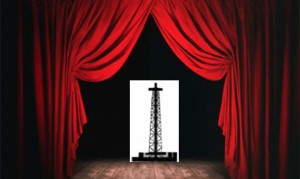 It All Comes Down To This Last Public Hearing and Final Vote on a New Drilling Ordinance
It All Comes Down To This Last Public Hearing and Final Vote on a New Drilling Ordinance
Beginning 1:00 PM
THIS WEDNESDAY, DECEMBER 11th
6th Floor Dallas City Hall
Participate, and (with any luck) Celebrate…..Over a Year of Constant Activism…….Over Three Years of Constant Organizing…….The Defeat of the Trinity East Permits………The Passage of Protective Dallas Gas Ordinance
After the Vote at City Hall. Come Raise a Glass with us at Lee Harvey's Bar, at 1807 Gould St.
THIS WEDNESDAY'S SCHEDULE
1:00 pm
Citizens' Press Conference
with special guests
1:30 pm
Final City Council Public Hearing on Gas-Drilling
ordinance
Following the Public Hearing, the City Council will have its final vote on the ordinance
Following the Council's vote, we'll reconvene at Lee Harvey's, the official bar of the Dallas Gas Wars.
Even if you Don't Live in Dallas, You Can Help Us Bring the REAL Barnett Shale to the Public Hearing on Wednesday
One of the constant refrains of our opponents on the Council is that drilling has been "going on for years in the Barnett Shale with no apparent harm." In particular, they love to use Fort Worth as a model for how Dallas should regulate gas drilling.
We know many of you have a different story to tell because you've experienced drilling up close and personal, or have family or friends who have.
The Dallas Residents at Risk alliance has put out a call for Wednesday's public hearing on the new gas ordinance that will proceed the final vote.
We're asking residents of the Barnett Shale who've been harmed by drilling to submit their testimony to the Dallas City Council.
You can do this directly by coming to the hearing Wednesday afternoon and testifying yourself, or you can submit you testimony to us at info@downwindersatrisk.org and we'll ask a Dallas resident to read it into the record for you.
We'll have these first-hand statements available for Dallas residents who want to help read them into the record at the 1pm press conference preceding the public hearing.
Our goal is to paint a more realistic picture of what it's like to live with gas drilling and production on a daily basis before the final vote on a new Dallas gas ordinance is taken. Please help us paint that picture.
How The Vote Looks as of Monday
Whatever happens on Wednesday, it'll be a close vote. There are still six votes against the new ordinance, and six votes for it. Mayor Rawlings, and Council members Jennifer Staubach-Gates and Dwaine Caraway are all officially undecided and hold the key to victory for either side. We must have at least 8 out of the 15 members vote with us to win.
Thanks to you, each of these three officially-undecided council members has received hundreds of e-mails supporting the new ordinance and its 1500-foot setback over the past week or so. We understand that they may be having an impact, along with phone calls, visits, and everything else residents are doing to try and persuade these three Council members to do the right thing. (If you still want to reach them here's their contact info.)
Thank you for doing all that you've done. We couldn't have gotten as far as we have without our army of citizen-lobbyists. But now we need your butt in a seat one last time at City Hall on Wednesday to close the deal. Please come if you can. Thanks.
D-Day Minus 7: Dallas Gas Ordinance Countdown
Considering how little public notice there was, yesterday's Dallas City Council "public comment time" on the new gas-drilling ordinance was well-attended by residents supporting the Plan Commission Draft. Over two dozen people spoke in favor of the CPC recommendations, including the 1500 foot setback, and/or stronger language for parks and flood plains. Murky statements by the Mayor about whether speaking this week would disqualify you from also having your say at next week's public hearing immediately prior to the final Council vote kept other residents from going to the podium.
True to whatever consultant's media training rule book they're following, industry representatives waited until they thought citizen testimony ended to make their condescending case that citizens were relying only on fear and didn't really understand the fracking process. The problem with this strategy is that you have to pretend the previous 45 minutes of citizen testimony never happened, since it's always replete with references to new scientific studies showing increased health harms from fracking, or another connection with earthquakes, or just strange foamy crap falling out of the sky into your yard from the rig down the street. It turns out the industry folks are the ones who don't really know the process.
And as fate would have it, citizens weren't through testifying. Right after telling the City Council how much West Dallas would lose out by not embracing fracking in its neighborhoods, up popped a West Dallas resident who said she wanted nothing to do with the industry, no matter how much money was involved. After another industry spokesman again said supporters of a stronger ordinance were just imagining harms they weren't really there, Sierra Club member Molly Rooke gave a devastatingly effective presentation on exactly how real harms to real people had forced her own group to acknowledge the dangers of gas pollution after initially endorsing natural gas as an entirely green fuel.
Unlike the staff briefing of two weeks ago, which allowed industry supporters on the Council to bloviate at will over what a crime it was to limit drilling in Big D, nobody behind the horseshoe did any talking except the Mayor, who was perfunctory in his opening and closing remarks and didn't give any clues as to his position on the CPC draft. According to Rawlings, it was his idea to have this "public comment time" prior to the final hearing so there wouldn't be the pile-up there was during the Trinity East vote, where you felt more like you were a cog in an assembly line instead of a citizen participating in one the small pageants of American democracy.
At the end of the meeting, Texas Campaign for the Environment members unfurled a banner urging Rawlings to "Be Strong," which was quickly confiscated by the City Hall Police Rapid Protest Response Team. Here's the Dallas Morning News' muted coverage of the event.
Because of the weather, Dallas Residents at Risk is waiting until next Monday to gin up a final push for passage of the Plan Commission draft going into Wednesday's final public hearing and vote beginning at 1 pm at City Hall. Please stay tuned for details about how you can express your public support and send a message to the Council to pass a strong ordinance. We know we sound like a broken record, but if you haven't sent a quick e-mail to the Mayor yet, you can click here and do so within a minute pretty painlessly. If you want a short explanation of what's going and what votes are where, you can read this previous post and get caught-up.
We have only a week to make sure our last year's worth of hard uphill slogging through corruption, double-dealing, and aggressively ignorant bureaucracies is not in vain. Please help us make it the last 1500 feet.
The New Gas Pollution Problem for DFW in Two Pictures
 So far the debate over how much impact the gas industry has had on DFW air quality has centered on the Barnett Shale. That's logical because that's the gas play right in front of us, in the middle of the North Texas "non-attainment area" for smog. One of the main arguments Rick Perry's Texas Commission on Environmental Quality has made against any significant impact is that most of the drilling is happening west of the DFW urban centers.
So far the debate over how much impact the gas industry has had on DFW air quality has centered on the Barnett Shale. That's logical because that's the gas play right in front of us, in the middle of the North Texas "non-attainment area" for smog. One of the main arguments Rick Perry's Texas Commission on Environmental Quality has made against any significant impact is that most of the drilling is happening west of the DFW urban centers.
Ignoring how geographically-incorrect this argument is – there's drilling and compressors in Dallas County right now, much less Ellis, Johnson. Denton and Tarrant – let's just cede the argument to the state that it would take gas fields to the Southeast of us, that is, upwind of us during ozone season, to really impact our air quality.
Guess what? There's gas fields Southeast of DFW that are producing lots of air pollution.
In previous posts over at least the last two years, we've shown that if you add up the standard permits of all the gas compressors in Freestone County alone, they represent more smog pollution than the Big Brown Coal Plant doing business down the road. Now there's new evidence of the size of these gas fields and their relationship to the DFW airshed, thanks to Google.
Here's a picture of the area we're talking about – just about an hour and a half drive southeast of DFW, east of Waco. That makes it directly upwind during ozone seasons.
When you zoom into where the green arrow is, you see the familiar sight of hundreds of square drilling pads laid out over the landscape – just like the Barnett Shale – only DFW is directly downwind of it during the summer.
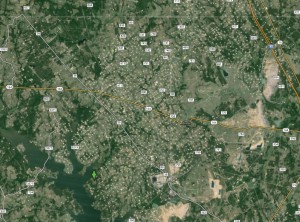 Pollution from these sources has most likely been grossly underestimated by the state. Moreover, when gas field pollution comes into an urban area with dirty air, it increases the likelihood of that pollution turning into smog. Rick Perry's employees are loath to admit the gas industry plays any part in the stagnation of DFW air quality progress since 2007, but as these images make clear, facts on the ground trump their ideology.
Pollution from these sources has most likely been grossly underestimated by the state. Moreover, when gas field pollution comes into an urban area with dirty air, it increases the likelihood of that pollution turning into smog. Rick Perry's employees are loath to admit the gas industry plays any part in the stagnation of DFW air quality progress since 2007, but as these images make clear, facts on the ground trump their ideology.
9 Days Until the End of the Dallas Gas Wars: What You Can Do
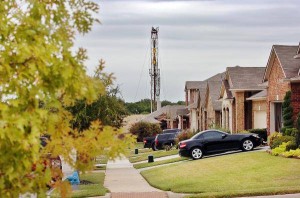 We only have 9 days to protect what it's taken us at least the last 12 months to build. The final Dallas City Council vote on a new gas drilling ordinance will take place on Wednesday, December 11th.
We only have 9 days to protect what it's taken us at least the last 12 months to build. The final Dallas City Council vote on a new gas drilling ordinance will take place on Wednesday, December 11th.
THIS WEDNESDAY – Tomorrow
December 4th
1 pm
Dallas City Council Mtg.
Dallas City Hall 6th Floor
Public Comment Being Taken on New Gas Drilling Ordinance
NEXT WEDNESDAY
December 11th
1 pm
Dallas City Council Mtg.
Dallas City Hall 6th Floor
Public hearing and VOTE on new Gas
Gas Drilling Ordinance
If you've come to City Hall on this issue recently, thank you, but we need you to show up again in the next two weeks and make sure our previous victories remain intact.
If you haven't shown up yet, or it's been a while, we really need some fresh faces to speak up and support the strongest ordinance we can get.
What's at Stake:
The 1500-foot buffer zone between drilling and compressor stations and neighborhoods.
This 1500-foot "setback" was supported by a 14-1 vote of the City Plan Commission in its recommendations to the City Council. It applies not only to gas drilling sites, but to large compressor stations too.
Flower Mound has a 1500-foot setback. The Lubbock Health Board has recommended a 1500-foot setback for that city. Denton has just voted for a 1200-foot setback.
Yet at least six city council members (Jerry Allen, Sheffe Kadane, Vonciel Hill, Tenell Atkins, Lee Kleinman, and Rick Callahan want to rollback that distance to allow drilling and compressor stations within just 1000 feet of neighborhoods and schools, and with "variances," as close as 500 feet.
Recently, old wells were activated in Denton that are as close as 600 feet to homes that were built since the leases were granted. According to press coverage last week, "residents in the Vintage neighborhood were not happy when they noticed "vibrations, noise and glare" about 600 feet from their homes…."
The disruption was so great that the City of Denton sued the gas drillers. "The actions of the Defendants are causing immediate and irreparable harm," the city's lawsuit said.
The Politics:
This is the kind of heavy industry these six city council members want to bring to Dallas neighborhoods, and they'll succeed if they can get Mayor Rawlings, Jennifer Gates and/or Dwaine Caraway to agree with them.
The rest of the council has made up its mind. It's the six backers of industry listed above vs. the six council members who voted to reject the Trinity East permits (Scott Griggs, Philip Kingston, Monica Alonzo, Adam Medrano, Sandy Greyson, and Carolyn Davis). Any motion needs 8 vote to win.
That's why these three Council members – Mayor Rawlings, Jennifer Gates, and Dwaine Caraway – will determine whether Dallas gets a more, or less protective gas drilling ordinance.
Mayor Rawlings has gone on record as opposing gas drilling in Dallas on principle. He's also gone on record saying he'd support the CPC recommendations. We need to make sure he keeps his word. He should be leading the charge for the most protective ordinance we can get.
Jennifer Gates ran on a platform of keeping drilling out of neighborhoods. We need to remind her of that and that she too needs to be leading the fight to keep the 1500 foot setback.
Dwaine Carway needs to be reminded that gas drilling is an environmental justice issue that will disproportionately hurt low income and minority areas of Dallas.
WHAT YOU CAN DO TO HELP:
1) Attend one or both of the next City Council meetings and ask the Council to pass the draft gas ordinance that the City Plan Commission recommended, including the 1500 foot setback.
2) If you haven't already, click here and send the Mayor a quick "click n' send" e-mail asking him to keep his word and support the Plan Commission recommendations iin total, including the 1500 foot setback. Please do this asap.
(We've added the e-mail addresses of both Jennifer Gates and Dwaine Carraway to the message to make sure they know how you feel.)
3) Contact Mayor Rawlings, Jennifer Gates and Dwaine Caraway on your own:
Mayor Rawlings
mike.rawlings@dallascityhall.com
Adam McGough, Chief of Staff
Phone: 214-670-7894
Dwaine Caraway
dwaine.caraway@dallascityhall.com,
214-670-0781
Jennifer Gates
Jennifer.gates@dallascityhall.com
Phone: 214-670-3816
4) Stay Tuned. They're more actions being planned leading up to the 11th so you can express your support for a strong ordinance. Keep on the lookout in your e-mailbox for alerts and on line here on the Downwinders' blog.
Scientific Support For a 1500-foot Setback
The 2012 Colorado School of Public Health study of cancer and non-cancer risks in the gas field, entitled "Human health risk assessment of air emissions from development of unconventional natural gas resources." This study concluded that residents living within a half-mile of a gas well had a 66% higher incidence of cancer than those living further away from a well.
The 2013 Emory University study found the risk of developing non-Hodgkin lymphoma increased among those living in proximity to facilities that release benzene. Natural gas facilities can release a lot of Benzene.
A 2012 report from Cornell University found that a mother's exposure to fracking before birth increases the overall prevalence of low birth weight by 25 percent.
Another 2012 Cornell University study that focused on animal health in the gas field concluded that reduced milk production, gastrointestinal, neurological, urological issues and sudden death are just a few of the symptoms experienced by livestock living near natural gas fracking sites.
Dr. Vikas Kapil of the National Center for Environmental Health at the U.S. Centers for Disease Control and Prevention gave a presentation in January 2012, saying "We do not have enough information to say with certainty whether shale gas drilling poses a threat to public health."
In addition, the Army Corp of Engineers recommends a distance of 3000 feet between structures like dams and levees and gas wells because of the danger of vibrations to structural integrity. If this distance is good enough for a dam, it's good enough to protect a home's foundation.
Smokey Joe Barton: the Frackers’ Favorite Congressman
 On Wednesday the DC-based campaign money watchdog group, Citizens for Responsibility and Ethics in Washington (CREW) released a report totaling up all the contributions to Congress from the nation's fracking industry fom 2004 to 2012 and found, to absolutely no one's surprise, that our own Smokey Joe Barton led all comers with over half a million of grateful cash collected.
On Wednesday the DC-based campaign money watchdog group, Citizens for Responsibility and Ethics in Washington (CREW) released a report totaling up all the contributions to Congress from the nation's fracking industry fom 2004 to 2012 and found, to absolutely no one's surprise, that our own Smokey Joe Barton led all comers with over half a million of grateful cash collected.
Since he was Chairman of the House Energy Committee for two of those years, and successfully led the effort to exempt fracking from federal environmental laws in the 2005 Energy Act, Barton is a favorite industry recipient.
But even the House Republicans have their limits. After his disastrous 2006 apology to former BP Chairman Tony Hayward for the White House's demand for $20 billion from the company for help in cleaning up its huge Gulf oil spill, the GOP decided that perhaps Smokey Joe wasn't the best face they cold put on energy policy and replaced him as Chairman. Now he's the senior member of his own Committee but isn't running it. Because this kind of money follows power, most of his large eight year total came before Barton got kicked to the gutter by his own party.
And it's why in just one campaign and less than two years, Texas' junior Senator Ted Cruz has already collected more than half of Barton's total, almost $300,000, from frackers, just shy of the amount our Senior Senator John Cornyn brought in over a much longer period of time. The industry is buying lots of tickets to climb aboard the Cruz presidential campaign band wagon. In another year's time it won't be shocking if Cruz surpasses Barton, even though he's not a Committee Chair or holds nay special influence in the Senate.
Dallas Ordinance Rolled Back Behind Closed Doors? 1500 Foot Buffer Zone In Danger on December 11th
 Wednesday's public staff briefing over the new gas drilling ordinance at Dallas City Hall was every bit as biased as you'd expect from a group that's been chafing under the Plan Commission's progressive recommendations since summer.
Wednesday's public staff briefing over the new gas drilling ordinance at Dallas City Hall was every bit as biased as you'd expect from a group that's been chafing under the Plan Commission's progressive recommendations since summer.
But it's the snow job that went on in he lengthy two-hour Executive Session that should really concern you – the one where the city attorney basically said Dallas would get sued if it adopted the Plan Commission's proposed 1500-foot setback that would separate neighborhoods from gas wells and compressor stations. It's when they're aren't any cameras or members of the public in the room that staff roll out their most spectacular spin. And the threat of a lawsuit is always good for a scare too.
As it happens, Flower Mound has saved Dallas a lot of trouble. That city also has a 1500 foot setback. And in fact, gas companies HAVE sued Flower Mound. And each time, Flower Mound has won.
And then there's Lubbock. Lubbock! A city where there are two political parties: Republicans and Libertarians. Lubbock's Board of Health recommended a setback of 1500 feet.
And yet, the Dallas City Council could end up running away from a standard even Lubbock doctors endorse come the December 11th vote on a new ordinance.
There are at least five very pro-industry members of the Dallas City Council who are now trying very hard to reduce that proposed 1500-foot setback to 1000 feet or less – Vonciel Hill, Jerry Allen, Sheffie Kadane, Terrell Atkins, and Rick Callahan. All of them were quite vocal in the Q&A session that followed the briefing yesterday, tripping over each other in carrying the industry's water, and all aiming at the 1500-foot setback, the linchpin of the Plan Commission's protections. You can read the DMN description of the sorry episode here.
What we still don't know after today is where the Mayor stands. He hemmed and hawed about public safety and fiduciary responsibility but didn't come down on one side or the other. Neither did Jennifer Gates. Or Dwaine Caraway. (Lee Kleinman was MIA.) These remain the only real unknowns, since citizen groups are expecting their six anti-Trinity East votes to hold here too. And of these unknowns, the Mayor is the most critical. He's on record as saying he'll support the CPC recommendations. Residents must make him accountable for that promise, or find themselves the victim of a policy that was made-up and decided behind closed doors.
To help you do just that, we've got a quick click and send e-mail you can use to tell Mayor Rawlings you want him to use his decisive vote to support the 1500-foot setback and the other provisons of the City Plan Commission draft ordinance.
It's not the only thing citizens need to do to mobilize between now and the December 11th public hearing and vote, but it's a start. Use it today.
Dallas Gas Ordinance Update: Council Briefing Wednesday, Council Hearing and Vote December 11th
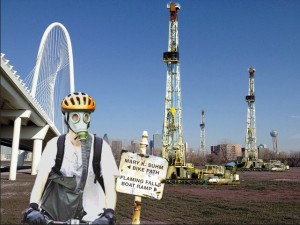 Mark your calendars now. According to City of Dallas materials published online Friday, the final council hearing and vote on a new gas drilling ordinance will take place Wednesday, December 11th.
Mark your calendars now. According to City of Dallas materials published online Friday, the final council hearing and vote on a new gas drilling ordinance will take place Wednesday, December 11th.
We might have a better idea about the likely outcome of that vote after tomorrow's briefing to the council by staff on the City Plan Commission recommendations that were adopted back in September. That's scheduled to take place between 9 am and lunch according to the council's agenda. Observers will be listening carefully to the comments and questions of the Mayor and Council to discern whether there are eight solid votes to adopt what's widely considered to be one of the most progressive gas drilling ordinances in the Barnett Shale, or whether opponents will have an opening to rollback key provisions, starting with the 1500-foot setback.
Rumor has it that work is already being done by at least one or two council members to write amendments to the Plan Commission draft to do just that. This is industry's last stand and they aren't likely to sit n their hands. Expect at least three to five hardcore driller-friendly council members to try and mount a charge. But they need eight to win.
As we've already noted, this is all now coming down to whether Mayor Rawlings will keep his word and support the product of the Plan Commission, as he said he would during his late August Trinity East soliloquy. If he likes the draft as is, chances are that's what we'll see adopted on the 11th. If he wants to tinker with it, then he'll allow that. The problem with opening it up to itemized changes is that nobody can predict what changes will win and what changes will lose, or how long such an amending process might take for such a detailed document. Things could get very messy and long.
Downwinders will be at tomorrow's staff briefing, trying to read the tea leaves like everyone else. We'll have a summary by tomorrow afternoon or Thursday morning. Stay tuned.
Dallas Drilling Update: It’s All About Holding Mayor Rawlings to His Word Now
“I am personally opposed to urban oil and gas drilling in Dallas.
To paraphrase Ecclesiastes, there is a place for everything under heaven, and I don’t think that place for drilling is in Dallas, in an environment like this.
We continue to grow, and there are generally too many unknowns in respect to urban drilling and its effects on our community’s health and safety. This city can be picky about what type of growth we have.
To that end, I will be supporting the efforts of our CPC on new gas drilling ordinances, to make sure the standards are such to ensure the safety of our citizens.”
– Dallas Mayor Mike Rawlings
August 28th, 2013
Statement before City Council vote on the Trinity East gas drilling and production Special Use Permits
On his way to vote in favor of allowing gas drilling in Dallas, the Mayor of North Texas' largest city seemingly endorsed a perpetual moratorium on gas drilling in Dallas.
And even as he endorsed a moratorium on gas drilling in Dallas, the Mayor also endorsed a City Plan Commission draft ordinance on gas drilling that still allows for it to take place, albeit under very selective conditions.
So which words from that August 28th declaration do we hold the Mayor to when the new gas ordinance comes up for a Council vote?
"I will be supporting the efforts of our CPC on new gas drilling ordinances"
That's all you need to know. There is no qualification there, no balance between the CPC draft and something else. Just full-throated endorsement of the draft, as is. Make him live up to this support in the form of a simple up-or-down vote on the entire ordinance and you've got one of the toughest new templates for how to regulate gas drilling in the state of Texas.
Forget about the first part. Even if you want a moratorium on drilling in Dallas, that's not the issue that will be up for a vote. Nor is there the slightest chance that such an option will appear as an alternative to the approval of a new gas ordinance, no matter how strongly Mayor Rawlings, or Scott Griggs, or Adam Medrano, or Philip Kingston personally feels about it. The choice is between the really bad old gas ordinance and the really good new gas ordinance.
Even if you think the ordinance could use improving (and everyone on this side of the aisle thinks it does), you don't have the votes on the council to improve it. Residents could only muster six "no" votes for the Trinity East fight. Fortunately, they only needed four. You need eight for each and every improvement you want to make to the gas ordinance. They aren't guaranteed.
Mayor Rawlings is one of only three or four mystery votes in the middle that determine the new ordinance's fate, and the most likely weather vane for the whole lot. As he goes, so probably goes North Dallas newcomers like Jennifer Gates and Lee Kleinman. Assuming residents can hold onto the "Trinity East Six," that gives you 8-9 votes. Then, seeing the winds shift, you don't know what other Council members you pick-up trying to get on the right side of things. Chances of improving the ordinance begin and end with the Mayor and what does the Mayor say? He's on the record as supporting the CPC draft, not the draft with some tweaks.
Of more concern to residents should be the eight votes that the other side might be able to muster to weaken some of the ordinance's key provisions by opening it up to individual itemized tallies. Industry starts out with at least five hard-core supporters. Add three votes to a rollback here or there, and the ordinance that it took months to make good might be completely unrecognizable by day's end. When you open up the draft to tweaks, you're taking a big gamble that you're only going to tweak it in good ways. There could be bad tweaks as well.
The safest, surest way to get what what industry is calling a de-facto moratorium on gas drilling in Dallas is having the Mayor agree to a single yes or no vote on the entire draft ordinance, an option he says he already supports. The new Dallas gas ordinance matches the lengthiest set backs in North Texas. It's tough on compressor pollution and location. It has robust disclosure language and insurance and bond requirements. It recommends a brand new air pollution off-set program for Dallas to explore. Is the ordinance perfect? No. But it's the best we can get with the votes that we have. And it's enough to keep drillers like Trinity East out of Dallas for good.
Improving it will take the assistance of Council members who aren't behind the dais yet. In the next municipal election cycle in 2015, almost half of the current City Council, and more than half of the ardent gas industry supporters, will be termed out. That's going to be the time to get the rest of your eight votes for a better gas drilling ordinance, and lots of other improvements as well.
Although there's still no date for an actual vote on the new gas ordinance, the city staff briefing – brace yourselves for one last Tammy Palomino appearance – to the Council is scheduled for the morning of Wednesday, November 6th at Dallas City Hall. If he Mayor wants this to go down smoothly, expect to hear a comment or two in support of the package as a whole being adopted. Residents might have a much clearer picture of where and how this will all be going down by session's end. Stay tuned.
